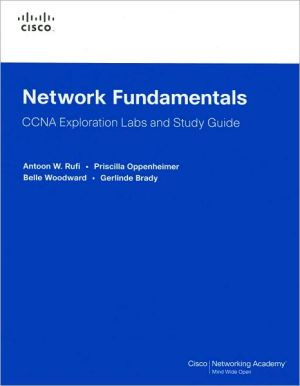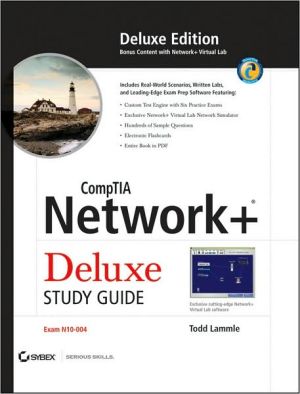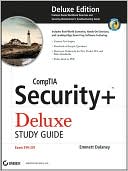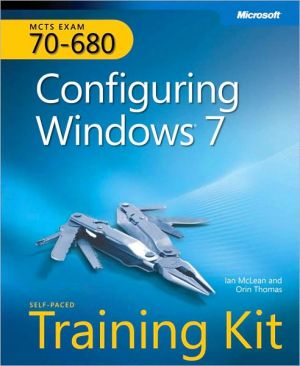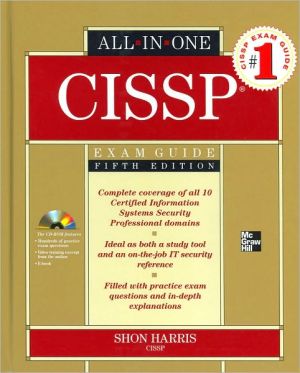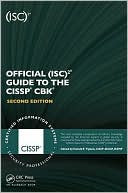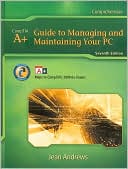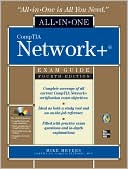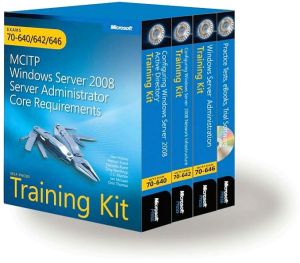Network Fundamentals: CCNA Exploration Labs and Study Guide (Cisco Networking Academy Series)
Network Fundamentals, CCNA Exploration Labs and Study Guide is designed to support your classroom and laboratory experience in Version 4 of the Cisco® Networking Academy® CCNA® Exploration curriculum. Each chapter contains a Study Guide section and a Labs and Activities section.\ Study Guide\ The dozens of exercises in this book help you learn the concepts and configurations crucial to your success as a CCNA exam candidate. Each chapter is slightly different and includes multiple-choice,...
Search in google:
Network Fundamentals, CCNA Exploration Labs and Study Guide is designed to support your classroom and laboratory experience in Version 4 of the Cisco® Networking Academy® CCNA® Exploration curriculum. Each chapter contains a Study Guide section and a Labs and Activities section.Study GuideThe dozens of exercises in this book help you learn the concepts and configurations crucial to your success as a CCNA exam candidate. Each chapter is slightly different and includes multiple-choice, fill-in-the-blank, and open-ended questions designed to help you: Review vocabulary Strengthen troubleshooting skills Boost configuration skills Reinforce concepts Research topicsLabs and ActivitiesHands-On Labs–This icon identifies the hands-on labs created for each chapter. Work through all the labs as provided to gain a deep understanding of CCNA knowledge and skills to ultimately succeed on the CCNA Certification Exam.Packet Tracer Companion–This icon identifies the companion activities that correspond to some hands-on labs. You use Packet Tracer to complete a simulation of the hands-on lab.Packet Tracer Skills Integration Challenge–Each chapter concludes with a culminating activity called the Packet Tracer Skills Integration Challenge. These challenging activities require you to pull together several skills learned from the chapter, as well as previous chapters, to successfully complete one comprehensive exercise.Use this book with:Network Fundamentals,CCNA ExplorationCompanion GuideISBN-10: 1-58713-208-7ISBN-13: 978-158713-208-7Companion CD-ROMThe CD-ROM provides all the Packet Tracer Companion and Packet Tracer Challenge files that are referenced throughout the book as indicated by the icons. These files work with Packet Tracer software V4.1.x, which is available through the Academy Connection website. Ask your instructor for access to the Packet Tracer software.This book is part of the Cisco Networking Academy Series from Cisco Press®. Books in this series support and complement the Cisco Networking Academy curriculum.
Chapter 1: Living in a Network-Centric World 1Communicating in a Network-Centric World 1Concept Questions 1Vocabulary Exercise: Completion 2Communication: An Essential Part of Our Lives 2Concept Questions 2The Network as a Platform 3Vocabulary Exercise: Define 3Vocabulary Exercise: Identify 3Vocabulary Exercise: Matching 4Vocabulary Exercise: Completion 4Concept Questions 5The Architecture of the Internet 5Vocabulary Exercise: Define 5Concept Questions 6Vocabulary Exercise: Completion 7Trends in Networking 8Multiple-Choice Questions 8Activity 1-1: Using Google Earth to View the World (1.1.1.4) 10Task 1: Install Google Earth 11Task 2: Run Google Earth 11Task 3: Navigate the Google Earth Interface 11Task 4: Reflection 13Task 5: Challenge 13Task 6: Clean Up 13Activity 1-2: Identifying Top Security Vulnerabilities (1.4.5.3) 13Task 1: Locate the SANS Resources 14Task 2: Review the SANS Resources 15Task 3: Collect Data 15Task 4: Reflection 16Task 5: Challenge 16Lab 1-1: Using Collaboration Tools: IRC and IM (1.6.1.1) 16Task 1: Configure the Chat Client 19Task 2: Connect to the Chat Server 20Task 3: Consider the Chat Session 21Task 4: Reflection 21Task 5: Challenge 22Task 6: Clean Up 22Lab 1-2: Using Collaboration Tools: Wikis and Web Logs (1.6.2.1) 22Task 1: Define the Terms Wiki and Blog 22Task 2: Explore Wiki Features with the TWiki Tutorial 23Task 3: Reflection 28Task 4: Challenge 28Task 5: Clean Up 28Skills Integration Challenge: Introduction to Packet Tracer (1.7.1.3) 28Task 1: Explore the PT Interface 30Task 2: Explore PT Operations 30Task 3: Review the Standard Lab Setup 32Task 4: Reflection 32Chapter 2: Communicating over the Network 33The Platform for Communications 33Concept Questions 33Vocabulary Exercise: Matching 34LANs, WANs, and Internetworks 34Vocabulary Exercise: Completion 34Vocabulary Exercise: Matching 35Protocols 36Vocabulary Exercise: Completion 36Concept Questions 36Using Layered Models 37Vocabulary Exercise: Matching 37Network Addressing 38Vocabulary Exercise: Completion 38Multiple-Choice Questions 38Activity 2-1: Using NeoTrace to View Internetworks (2.2.5.1) 39Task 1: Trace Route to Remote Server 40Task 2: Trace Route Using NeoTrace 41Task 3: Reflection 41Task 4: Challenge 41Task 5: Clean Up 41Lab 2-1: Topology Orientation and Building a Small Network (2.6.1.1) 42Task 1: Create a Peer-to-Peer Network 43Task 2: Identify the Cables Used in a Network 43Task 3: Cable the Peer-to-Peer Network 43Task 4: Connect Your Workstations to the Classroom Lab Switch 47Task 5: Reflection 48Packet Tracer Companion: Topology Orientation and Building a Small Network (2.6.1.2) 48Lab 2-2: Using Wireshark to View Protocol Data Units (2.6.2.1) 49Task 1: Ping PDU Capture 53Task 2: FTP PDU Capture 56Task 3: HTTP PDU Capture 58Task 4: Reflection 58Task 5: Challenge 58Task 6: Cleanup 59Packet Tracer Companion: Using Packet Tracer to View Protocol Data Units (2.6.2.2) 59Skills Integration Challenge: Examining Packets (2.7.1.3) 59Task 1: Complete the Topology 60Task 2: Add Simple PDUs in Real-Time Mode 61Task 3: Analyze PDUs in Simulation Mode (Packet Tracing) 61Task 4: Experiment with the Model of the Standard Lab Setup 61Task 5: Reflection 61CHapter 3: Application Layer Functionality and Protocols 63Applications: The Interface Between the Networks 63Vocabulary Exercise: Matching 64Concept Questions 64Making Provisions for Applications and Services 65Vocabulary Exercise: Matching 65Multiple-Choice Questions 65Application Layer Protocols and Services Examples 66Vocabulary Exercise: Matching 66Vocabulary Exercise: Completion 66Multiple-Choice Questions 67Activity 3-1: Data Stream Capture (3.4.1.1) 69Task 1: Create a Sound File 69Task 2: Observe the Properties of the Audio File 70Task 3: Reflection 71Task 4: Clean Up 71Lab 3-1: Managing a Web Server (3.4.2.1) 71Task 1: Download, Install, and Verify the Apache Web Server 73Task 2: Verify the Default Web Server Configuration File 76Task 3: Capture and Analyze HTTP Traffic with Wireshark 77Task 4: Challenge 78Task 5: Reflection 78Task 6: Clean Up 79Lab 3-2: E-mail Services and Protocols (3.4.3.1) 79Task 1: Configure the Pod Host Computer for E-mail Service 81Task 2: Capture and Analyze E-mail Communication Between the Pod Host Computer and an E-mail Server 84Task 3: Challenge 86Task 4: Reflection 86Task 5: Clean Up 86Skills Integration Challenge: Configuring Hosts and Services (3.5.1.3) 87Task 1: “Repair” and Test the Topology 88Task 2: Explore How DNS and HTTP Work Together 89Task 3: Reflection 89Chapter 4: OSI Transport Layer 91Roles of the Transport Layer 91Vocabulary Exercise: Matching 91Concept Questions 92Vocabulary Exercise: Completion 92Port Type Ranges Exercise 92The TCP Protocol: Communicating with Reliability 92Concept Questions 93Vocabulary Exercise: Matching 93Managing TCP Sessions 93Internet Research Exercise 93Concept Questions 94The UDP Protocol: Communicating with Low Overhead 94Vocabulary Exercise: Completion 94Lab 4-1: Observing TCP and UDP Using netstat (4.5.1.1) 95Task 1: Explain Common netstat Command Parameters and Outputs 96Task 2: Use netstat to Examine Protocol Information on a Pod Host Computer 98Task 3: Reflection 100Task 4: Challenge 100Task 5: Cleanup 100Lab 4-2: TCP/IP Transport Layer Protocols, TCP and UDP (4.5.2.1) 100Task 1: Identify TCP Header Fields and Operation Using a Wireshark FTP Session Capture 102Task 2: Identify UDP Header Fields and Operation Using a Wireshark TFTP Session Capture 108Task 3: Reflection 110Task 4: Challenge 111Task 5: Cleanup 111Lab 4-3: Application and Transport Layer Protocols (4.5.3.1) 111Task 1: Configure the Pod Host Computer to Capture Application Layer Protocols 113Task 2: Capture and Analyze HTTP Communication Between the Pod Host Computer and a Web Server 113Task 3: Capture and Analyze FTP Communication Between the Pod Host Computer and a Web Server 116Task 4: Reflection 121Task 5: Challenge 121Task 6: Clean Up 122Packet Tracer Companion: Application and Transport Layer Protocols Examination (4.5.3.2) 122Skills Integration Challenge: Analyzing the Application and Transport Layers (4.6.1.3) 122Task 1: Repair and Test the Topology 123Task 2: Explore How DNS, UDP, HTTP, and TCP Work Together 124Task 3: Reflection 124Chapter 5: OSI Network Layer 125IPv4 125Concept Questions 125Vocabulary Exercise: Completion 126Vocabulary Exercise: Define 126Networks: Dividing Hosts into Groups 127Internet Research Exercise 127Vocabulary Exercise: Completion 127Routing: How Our Data Packets Are Handled 127Concept Questions 127Vocabulary Exercise: Define 128Routing Processes: How Routes Are Learned 129Vocabulary Exercise: Completion 129Lab 5-1: Examining a Device’s Gateway (5.5.1.1) 130Task 1: Understand and Explain the Purpose of a Gateway Address 132Task 2: Understand How Network Information Is Configured on a Windows Computer 134Task 3: Troubleshoot a Hidden Gateway Address Problem 136Task 4: Reflection 137Task 5: Challenge 137Task 6: Clean Up 137Packet Tracer Companion: Examining a Device’s Gateway (5.5.1.2) 137Lab 5-2: Examining a Route (5.5.2.1) 138Task 1: Use the route Command to Modify a Windows Computer Routing Table 139Task 2: Use a Windows Telnet Client Command telnet to Connect to a Cisco Router 144Task 3: Examine Router Routes Using Basic Cisco IOS Commands 145Task 4: Reflection 147Task 5: Challenge 147Task 6: Clean Up 147Packet Tracer Companion: Examining a Route (5.5.2.2) 148Skills Integration Challenge: Routing IP Packets (5.6.1.3) 148Task 1: Configure a Router Interface 149Task 2: Examining Routes 149Task 3: Configure a Route Using a GUI 150Task 4: Examine the Routing of the IP Packet 150Task 5: Reflection 150Chapter 6: Addressing the Network: IPv4 151IPv4 Addresses 151Concept Questions 151Binary-to-Decimal Conversion Exercise 152Decimal-to-Binary Conversion Exercise 152Addresses for Different Purposes 152Vocabulary Exercise: Matching 152Internet Research Exercise 153Vocabulary: Completion 153Concept Questions 153Assigning Addresses 154Internet Research Exercises 154Concept Questions 154Is It on My Network? 155Binary Matching Exercise 155Concept Questions 156Internet Research Exercise 156Calculating Addresses 156Concept Questions 156Multiple-Choice Questions 157Testing the Network Layer 157Concept Questions 157Vocabulary Exercise: Completion 158Lab 6-1: Ping and Traceroute (6.7.1.1) 159Task 1: Use the ping Command to Verify Simple TCP/IP Network Connectivity 160Task 2: Use the tracert Command to Verify TCP/IP Connectivity 164Task 3: Challenge 166Task 4: Reflection 168Task 5: Clean Up 168Packet Tracer Companion: ping and traceroute (6.7.1.2) 168Lab 6-2: Examining ICMP Packets (6.7.2.1) 169Task 1: Understand the Format of ICMP Packets 170Task 2: Use Wireshark to Capture and Examine ICMP Messages 173Task 3: Challenge 177Task 4: Reflection 177Task 5: Clean Up 177Packet Tracer Companion: Examining ICMP Packets (6.7.2.2) 177Activity 6-1: IPv4 Address Subnetting, Part 1 (6.7.3.1) 178Task 1: For a Given IP Address, Determine Network Information 178Task 2: Challenge 180Task 3: Clean Up 182Activity 6-2: IPv4 Address Subnetting, Part 2 (6.7.4.1) 183Task 1: For a Given IP Address and Subnet Mask, Determine SubnetInformation 184Task 2: Challenge 188Task 3: Clean Up 191Lab 6-3: Subnet and Router Configuration (6.7.5.1) 192Task 1: Subnet the Address Space 192Task 2: Determine Interface Addresses 193Task 3: Configure the Serial and FastEthernet Addresses 193Task 4: Verify the Configurations 193Task 5: Reflection 194Packet Tracer Companion: Subnet and Router Configuration (6.7.5.2) 194Skills Integration Challenge: Planning Subnets and Configuring IP Addresses (6.8.1.3) 194Task 1: IP Subnet Planning 195Task 2: Finish Building the Network in Packet Tracer 196Task 3: Configure the Network 197Task 4: Test the Network 197Task 5: Reflection 197Chapter 7: OSI Data Link Layer 199Data Link Layer: Accessing the Media 199Vocabulary Exercise: Matching 199Concept Questions 199Vocabulary Exercise: Completion 200Media Access Control Techniques 200Concept Questions 200Vocabulary Exercise: Completion 201Media Access Control: Addressing and Framing Data 201Vocabulary Exercise: Matching 201Concept Questions 202Putting It All Together: Follow Data Through an Internetwork 203Vocabulary Exercise: Completion 203Lab 7-1: Frame Examination (7.5.2.1) 205Task 1: Explain the Header Fields in an Ethernet II Frame 206Task 2: Use Wireshark to Capture and Analyze Ethernet II Frames 209Task 3: Challenge 212Task 4: Reflection 212Task 5: Clean Up 213Skills Integration Challenge: Data Link Layer Issues (7.6.1.3) 213Task 1: IP Subnet Planning 214Task 2: Finish Building the Network in Packet Tracer, Attending to Some Layer 2 Issues 215Task 3: Configure the Network 215Task 4: Test the Network 216Task 5: Reflection 216Chapter 8: OSI Physical Layer 217The Physical Layer: Communication Signals 217Vocabulary Exercise: Completion 217Concept Questions 217Physical Signaling and Encoding: Representing Bits 218Concept Questions 218Vocabulary Exercise: Completion 218Vocabulary Exercise: Matching 218Physical Media: Connecting Communication 219Concept Questions 219Vocabulary Exercise: Matching 219Lab 8-1: Media Connectors Lab Activity (Lab 8.4.1.1) 220Task 1: Become Familiar with the Most Common Functions of a Cable Tester 221Task 2: Test Different Cables for Type and Wiring Problems 223Task 3: Perform Initial Configuration of the Fluke LinkRunner 224Task 4: Verify Cable Length 226Task 5: Reflection 226Task 6: Challenge 226Task 7: Clean Up 226Skills Integration Challenge: Connecting Devices and Exploring the Physical View (8.5.1.3) 227Task 1: Connect the Devices in the Standard Lab Setup 228Task 2: View the Standard Lab Setup in the Physical Workspace 228Chapter 9: Ethernet 231Overview of Ethernet 231Vocabulary Exercise: Matching 231Concept Questions 232Ethernet: Communication Through the LAN 232Vocabulary Exercise: Matching 232Concept Questions 233The Ethernet Frame 234Vocabulary Exercise: Matching 234Multiple-Choice Questions 234Concept Questions 235Ethernet Media Access Control 236Vocabulary Exercise: Completion 236Concept Questions 236Ethernet Physical Layer 237Vocabulary Exercise: Completion 237Hubs and Switches 238Vocabulary Exercise: Matching 238Vocabulary Exercise: Completion 238Concept Question 238Address Resolution Protocol (ARP) 239Multiple-Choice Questions 239Lab 9-1: Address Resolution Protocol (9.8.1.1) 241Task 1: Use the Windows arp Command 242Task 2: Use Wireshark to Examine ARP Exchanges 246Task 3: Reflection 248Task 4: Challenge 248Task 5: Clean Up 248Packet Tracer Companion: Address Resolution Protocol (9.8.1.2) 249Lab 9-2: Cisco Switch MAC Table Examination (9.8.2.1) 249Task 1: Use the Telnet Protocol to Log in to a Cisco Switch 251Task 2: Use the Cisco IOS show mac-address-table Command to Examine MAC Addresses and Port Associations 251Task 3: Challenge 253Task 4: Reflection 253Task 5: Clean Up 253Packet Tracer Companion: Cisco Switch MAC Table Examination (9.8.2.2) 253Lab 9-3: Intermediary Device as an End Device (9.8.3.1) 253Task 1: Use Wireshark to Capture and Analyze Frames Originating from Network Nodes 255Task 2: Examine the Origination of Frames in a Small Network 256Task 3: Reflection 258Task 4: Challenge 259Task 5: Clean Up 259Packet Tracer Companion: An Intermediary Device as an End Device (9.8.3.2) 259Skills Integration Challenge: Switched Ethernet (9.9.1.3) 259Task 1: IP Subnet Planning 260Task 2: Repair Problems with the Ethernet Switched LAN 261Task 3: Test the Network 261Task 4: Reflection 261Chapter 10: Planning and Cabling Networks 263LANs: Making the Physical Connection 263Concept Questions 263Multiple-Choice Questions 264Vocabulary Exercise: Completion 264Device Interconnections 264Concept Questions 264Vocabulary Exercise: Completion 265Developing an Addressing Scheme 266Concept Questions 266Vocabulary Exercise: Completion 266Multiple-Choice Questions 266Calculating the Subnets 267Concept Questions 267Device Interconnections 268Concept Question 268Multiple-Choice Questions 268Lab 10-1: How Many Networks? (10.3.2.2) 269Task 1: Determine the Number of Subnets in Topology Diagram A 269Task 2: Record Subnet Information 270Task 3: Determine the Number of Subnets in Topology Diagram B 270Task 4: Record Subnet Information 271Task 5: Determine the Number of Subnets in Topology Diagram C 271Task 6: Record Subnet Information 272Task 7: Determine the Number of Subnets in Topology Diagram D 272Task 8: Record Subnet Information 273Task 9: Reflection 273Lab 10-2: Creating a Small Lab Topology (10.6.1.1) 274Task 1: Design the Logical Network 275Task 2: Configure the Physical Lab Topology 277Task 3: Configure the Logical Topology 277Task 4: Verify Network Connectivity 279Task 5: Reflection 280Task 6: Challenge 280Task 7: Clean Up 280Packet Tracer Companion: Creating a Small Topology (10.6.1.2) 280Lab 10-3: Establishing a Console Session with HyperTerminal (10.6.2.1) 281Task 1: Connect a Router and Computer with a Console Cable 282Task 2: Configure HyperTerminal to Establish a Console Session with a Cisco IOS Router 282Task 3: Configure HyperTerminal to Establish a Console Session with a Cisco IOS Switch 284Task 3: Reflection 286Task 4: Challenge 286Task 5: Clean Up 286Lab 10-3 (Alternative): Establishing a Console Session with TeraTerm 287Task 1: Connect a Router and Computer with a Console Cable 287Task 2: Configure TeraTerm Web to Establish a Console Session with the Router 288Task 3: Reflection 288Task 4: Challenge 289Task 5: Clean Up 289Packet Tracer Companion: Establishing a Console Session with PT Terminal (10.6.2.2) 289Lab 10-4: Establishing a Console Session with Minicom (10.6.3.1) 290Task 1: Connect a Router and Computer with a Console Cable 290Task 2: Configure Minicom to Establish a Console Session with the Router 291Task 3: Perform Basic Commands 292Task 4: Reflection 292Task 5: Clean Up 293Skills and Integration Challenge: Planning and Cabling Networks (10.7.1.3) 293Task 1: Build the Network Topology 294Task 2: Create and Assign an Addressing Scheme 294Task 3: Interface Configuration 295Task 4: Testing Connectivity 295Chapter 11: Configuring and Testing Your Network 297Configuring Cisco Devices: IOS Basics 297Concept Questions 297Vocabulary Exercise: Matching 298Cisco IOS Command Exercises 298Test Your Knowledge 299Applying a Basic Configuration Using Cisco IOS 299Concept Questions 299Multiple-Choice Questions 300Vocabulary Exercise: Completion 301Verifying Connectivity 301Test Your Knowledge 301Concept Question 301Lab 11-1: Network Latency Documentation with ping (11.4.3.3) 302Task 1: Use the ping Command to Document Network Latency 303Task 2: Compute Various Statistics on the Output of a ping Capture 304Task 3: Measure Delay Effects from Larger Datagrams 306Task 4: Reflection 308Task 5: Challenge 309Lab 11-2: Basic Cisco Device Configuration (11.5.1.1) 310Task 1: Configure Cisco Router Global Configuration Settings 312Task 2: Configure Cisco Router Password Access 315Task 3: Configure Cisco Router Interfaces 317Task 4: Save the Router Configuration Files 319Task 5: Configure a Cisco Switch 320Task 6: Reflection 323Task 7: Challenge 324Task 8: Clean Up 325Packet Tracer Companion: Basic Cisco Device Configuration (11.5.1.2) 326Lab 11-3: Managing Device Configuration (11.5.2.1) 327Task 1: Configure Network Connectivity 328Task 2: Use TFTP to Save and Restore a Cisco IOS Configuration 329Task 3: Reflection 333Task 4: Challenge 333Task 5: Clean Up 335Packet Tracer Companion: Managing Device Configuration (11.5.2.2) 335Lab 11-4: Configure Host Computers for IP Networking (11.5.3.1) 336Task 1: Design the Logical Lab Topology 337Task 2: Configure the Physical Lab Topology 338Task 3: Configure the Logical Topology 338Task 4: Verify Network Connectivity 340Task 5: Reflection 341Task 6: Challenge 341Task 7: Clean Up 341Lab 11-5: Network Testing (11.5.4.1) 342Task 1: Design the Logical Lab Topology 343Task 2: Configure the Physical Lab Topology 345Task 3: Configure the Logical Topology 345Task 4: Verify Network Connectivity 349Task 5: Reflection 350Task 6: Challenge 350Task 7: Clean Up 351Lab 11-6: Network Documentation with Utility Commands (11.5.5.1) 352Task 1: Design the Logical Lab Topology 353Task 2: Configure the Physical Lab Topology 354Task 3: Configure the Logical Topology 354Task 4: Verify Network Connectivity 356Task 5: Document the Network 357Task 6: Reflection 358Task 7: Challenge 358Task 8: Clean Up 359Lab 11-7: Case Study: Datagram Analysis with Wireshark (11.5.6.1) 359Task 1: Prepare the Lab 361Task 2: Review the Process of Data Flowing Through the Network 361Task 3: Analyze Captured Packets 363Task 4: Complete the Final Analysis 365Task 5: Conclusion 367Task 6: Summary 367Skills Integration Challenge: Configuring and Analyzing Networks (11.6.1.3) 367Task 1: Plan 368Task 2: Build and Configure the Network 369Task 3: Test and Analyze 370Task 4: Reflection 370
